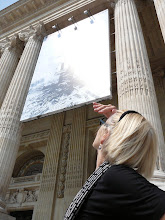Published in the New York Times,
By WILLIAM GRIMES
Aldo Crommelynck, a master printmaker whose self-effacing style and virtuosic command of traditional techniques coaxed the best out of European artists including Picasso, Braque and Matisse, and later helped younger American artists like Jim Dine and Jasper Johns express their visions on paper, died at his home in Paris on Dec. 22. He was 77.
His death had been reported in some online art magazines and some European newspapers but not widely elsewhere. The cause was pneumonia, said Dick Solomon, president of Pace Prints in
Mr. Crommelynck collaborated with Picasso for more than 20 years and produced all of his prints after 1961. After setting up a studio near Picasso's home in Mougins in 1963, he collaborated on the 750 prints that Picasso had created in his last decade, including the erotic etchings that make up ''Series 347,'' generated in a creative frenzy in 1968.
In 1986 Mr. Crommelynck entered into the partnership with Pace and established a New York studio, where he worked with a long list of prominent American artists, among them Ed Ruscha, Chuck Close, Alex Katz and Mr. Dine, who titled his 2007 one-man show at the Bibliothèque Nationale in Paris ''Aldo et Moi.''
''He was one of the great printers of the 20th century, an alchemist as much as a master technician,'' said Adam D. Weinberg, director of the Whitney
Aldo Crommelynck, the son of the Belgian playwright Fernand Crommelynck, was born in
Instead, he applied himself to copying the works of other artists for reproduction and to mastering the intricacies of intaglio, a printing method in which an image is incised on a plate, usually copper or zinc. Ink is then applied to the plate surface and wiped off, and the ink remaining in the incised lines is transferred to paper by a press.
Mr. Crommelynck, who became renowned for the richness and evenness of his aquatint grounds, soon emerged as the principal creative force at Lacourière's studio, where he worked with major artists like Léger, Masson, Rouault and Miró. He assisted Matisse on the aquatint series ''Visages'' (1945-52) and formed an especially close working relationship with Picasso.
In 1955 Mr. Crommelynck founded his own atelier in
''I knew what he achieved in his paintings could perfectly well be achieved in copper also,'' Mr. Crommelynck said.
In 1963, when Picasso decided that he needed a printmaker close to his house in Mougins, in the south of France, Mr. Crommelynck set up a studio nearby and assisted on ''Series 60'' (1966-68), ''Series 347'' and ''Series 156'' (1970-72).
''Picasso was a whirlwind, but Aldo could keep up,'' Mr. Solomon said.
After Picasso's death in 1973, Mr. Crommelynck returned to Paris, where his atelier attracted British artists like Richard Hamilton, David Hockney and Howard Hodgkin and a contingent of younger American artists, including Mr. Dine, Mr. Johns and David Salle.
''He was an absolute master of every possibility in intaglio printing, with a real bag of techniques and tricks,'' said Mr. Dine, who collaborated with Mr. Crommelynck on more than 100 prints. ''He taught me everything I know about etching.''
Mr. Crommelynck worked with Mr. Dine on the 25-print series ''Nancy Outside in July'' (1977-81) and on prints derived from Mr. Dine's paintings of hearts and bathrobes. He assisted Mr. Johns on his etchings for an edition of Beckett's prose fragments titled ''Foirades/Fizzles'' (1976), as well as for the series ''Corpse and Mirror'' (1973-75) and ''Land's End'' (1978-79).
''He was an intergenerational figure,'' Mr. Weinberg said. ''He worked with the great artists of the
After a falling out with his brother, Mr. Crommelynck, at Mr. Dine's urging, entered into the partnership with Mr. Solomon at Pace in 1986 to publish prints by American artists. From a printing studio in SoHo, he collaborated on projects with George Condo, Claes Oldenburg, Donald Sultan, Terry Winters, Keith Haring and Jean-Michel Basquiat.
In 1989 Mr. Weinberg organized a tribute exhibition, ''Aldo Crommelynck Master Prints With American Artists,'' at the
Tall and gaunt, with piercing eyes, Mr. Crommelynck cut a bizarre but elegant figure. He
was, Mr. Solomon said, ''a dead ringer for Ichabod Crane, with incredibly long, spindly fingers.''
Artists loved him, even those with little or no experience in printmaking, whom he nudged toward success through hints and gentle direction. Constant revisions and corrections did not faze him, and he remained calm and introverted in the face of artistic tempests.
''He did not compete,'' Mr. Dine said. ''He was there to help you give birth to whatever image you had in mind.''
Mr. Crommelynck was wily. Red Grooms, who created large-scale, densely populated scenes of the Deux Magots cafe in Paris and the Grand Concourse at Grand Central Terminal with Mr. Crommelynck, took time out to do a portrait of Mr. Crommelynck at work in a tweed jacket.
''He had an idea about how to reproduce the texture of the jacket,'' Mr. Grooms said. ''He told me to get a bit of fabric, so I ran out on
He was also game. For Chuck Close's ''Spitbite'' etchings, Mr. Crommelynck, a chain smoker, contributed his own saliva to the acid mixture used to incise the image on the plate.
''I think it was all those Gauloise cigarettes Aldo smoked,'' Mr. Close told the curator Terry Sultan in 1988. ''My spit never seemed to work as well.''

